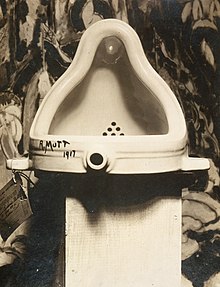
Back Fountain Afrikaans النافورة (دوشامب) Arabic Фантан (Дзюшан) Byelorussian Fontaine (Duchamp) Breton Font (Duchamp) Catalan Fontána (Duchamp) Czech Fountain Danish Fountain (Duchamp) German Κρήνη (Ντυσάν) Greek Fontano (Duchamp) Esperanto

Fountain is a readymade sculpture by Marcel Duchamp in 1917, consisting of a porcelain urinal signed "R. Mutt". In April 1917, an ordinary piece of plumbing chosen by Duchamp was submitted for the inaugural exhibition of the Society of Independent Artists, to be staged at the Grand Central Palace in New York. When explaining the purpose of his readymade sculpture, Duchamp stated they are "everyday objects raised to the dignity of a work of art by the artist's act of choice."[2] In Duchamp's presentation, the urinal's orientation was altered from its usual positioning.[3][4][5] Fountain was not rejected by the committee, since Society rules stated that all works would be accepted from artists who paid the fee, but the work was never placed in the show area.[6] Following that removal, Fountain was photographed at Alfred Stieglitz's studio, and the photo published in the Dada journal The Blind Man. The original has been lost.
The work is regarded by art historians and theorists of the avant-garde as a major landmark in 20th-century art. Sixteen replicas were commissioned from Duchamp in the 1950s and 1960s and made to his approval.[7] Some have suggested that the original work was by the female artist Elsa von Freytag-Loringhoven[8][9] who had submitted it to Duchamp as a friend, but art historians maintain that Duchamp was solely responsible for Fountain's presentation.[3][10][11]
Fountain is included in the Marcel Duchamp catalogue raisonné by Arturo Schwarz; The complete works of Marcel Duchamp (number 345).[12]
- ^ Tomkins, Duchamp: A Biography, p. 186.
- ^ Martin, Tim (1999). Essential Surrealists. Bath: Dempsey Parr. p. 42. ISBN 1-84084-513-9.
- ^ a b "Fountain, Marcel Duchamp, 1917, replica, 1964". tate.org.uk. Tate. Retrieved 5 October 2018.
- ^ Gavin Parkinson, The Duchamp Book: Tate Essential Artists Series, Harry N. Abrams, 2008, p. 61, ISBN 1854377663
- ^ Dalia Judovitz, Unpacking Duchamp: Art in Transit, University of California Press, 1998, pp. 124, 133, ISBN 0520213769
- ^ Cabanne, P., & Duchamp, M. (1971). Dialogues with Marcel Duchamp Archived 15 November 2017 at the Wayback Machine
- ^ "An Overview of the Seventeen Known Versions of Fountain". 2007.
- ^ "Duchamp and the pissoir-taking sexual politics of the art world". TheGuardian.com. 7 November 2014.
- ^ Hustvedt, Siri (2019-03-29). "When will the art world recognise the real artist behind Duchamp's Fountain?". The Guardian. ISSN 0261-3077. Retrieved 2019-03-31.
- ^ Camfield, William A. (1989). Marcel Duchamp, Fountain. Houston, TX: Houston Fine Art Press. p. 183. ISBN 0939594102. LCCN 87028248.
- ^ For a recent analysis of the reception of this story, see Krajewski, Michael: "Beuys. Duchamp: Two Stories. Two Artist Legends." In: Beuys & Duchamp. Artists of the Future. Magdalena Holzhey, Katharina Neuburger, Kornelia Röder, eds., Krefelder Kunstmuseen, Berlin 2021, p. 337-345, ISBN 978-3-7757-5068-4
- ^ Arturo Schwarz, The complete works of Marcel Duchamp, New York, Delano Greenidge, 2000